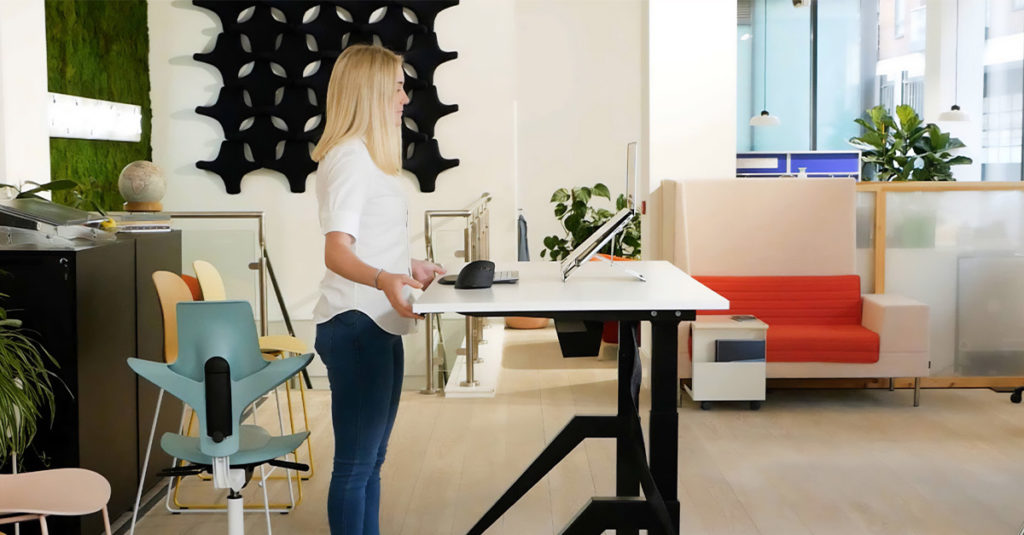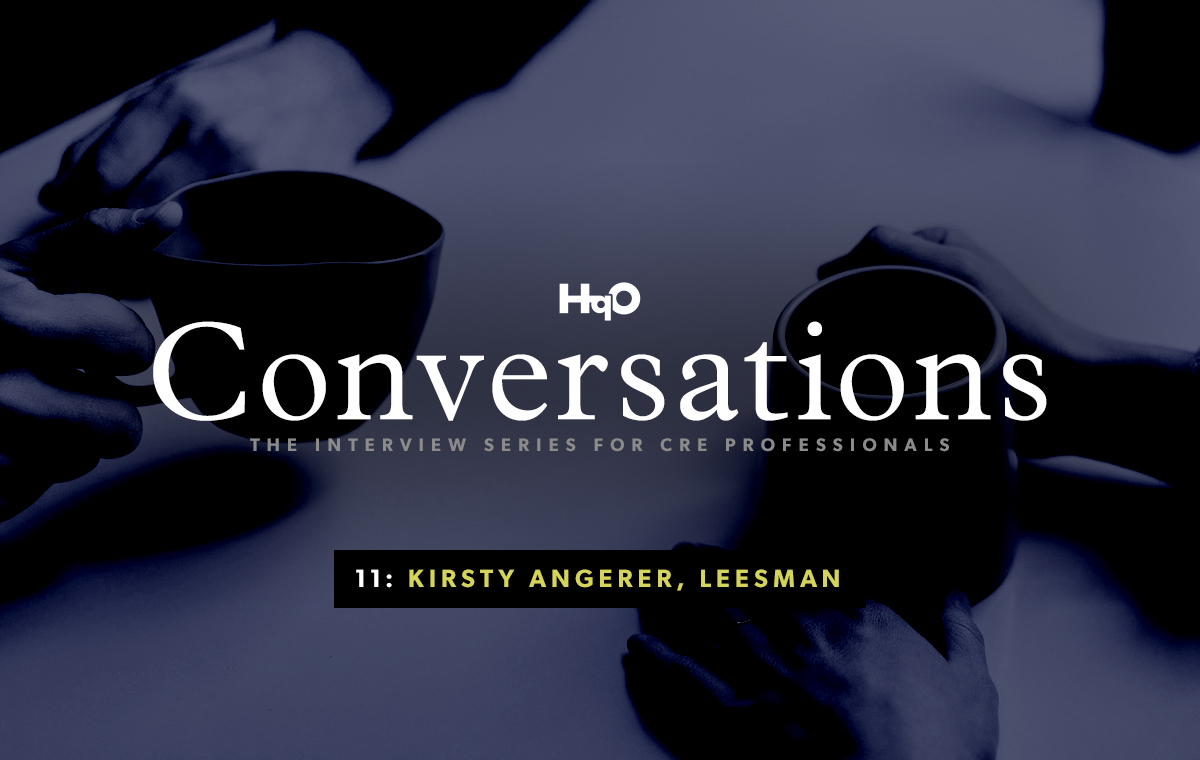Kirsty Angerer
Development Director at Leesman
Kirsty Angerer is currently a Development Director at Leesman, helping to equip executives at all levels to make informed, forward-thinking decisions that allow them to mitigate risk, plan for the future, and benefit from great employee workplace experiences. Her passion for human-centric design — and the interactions among humans and their workplaces — stems from over 10 years of experience in the industry. She has worked internationally with subject matter experts and Fortune 500 companies to enhance people’s health and optimize performance through developing and implementing ergonomics programs, as well as influencing the design of workplaces.

Thank you for joining us, Kirsty! To kick things off, can you tell our readers a little bit about your role and your background in the industry?
Absolutely! My background is actually in Ergonomics and Human Factors. I’ve spent the last 10 or 12 years working with organizations, helping them build their ergonomic strategies. That means helping them to understand how we interact with each other, how we interact with the tools that we’re working with, and then also how we interact with the space around us — whether that’s a home, in the office, or everything in between.
It’s been a very interesting career working in the workplace sector. I’ve been very fortunate to see some of the most outstanding buildings around the world, and obviously some of the not-so-brilliant buildings. But, of course, my role has been to identify opportunities to improve those spaces for the people that are ultimately going to be working in them, and that’s what has directed my purpose.
Your background is so unique — did you spend that entire time with Leesman? How did you evolve into your current role?
I actually studied Ergonomics and Human Factors at university, and then very quickly ended up in the workplace sector. I spent many years working internationally, so I’ve traveled a lot throughout the UK, Australia, the Middle East, Asia, and Europe. I actually only recently joined Leesman in the last four months as a Development Director. It’s an opportunity for me to bring my Human Factors lens to the conversations that we’re having with our clients. My role at Leesman is to understand employee needs and experience for each organization I’m working with, and to share those insights. Armed with this data, organizations can improve their workplace experience, channel investment where it makes the most impact, and continue to engage employees by meeting their needs.
That’s such a unique trajectory. In your own words, what does Leesman do and how does your role match their larger goals and vision?
Leesman measures and analyzes employee experience. In fact, we have the largest global database of employee experience data. This means we can help organizations understand their workplace by drawing from those intimate insights on what people are saying about their office or home experience. Given that, we have such incredible levels of data — and, of course, learnings from the past few years when the pandemic began. I think it’s really important to share those trends and research insights, which is why we do regular webinars, events and research briefings. Culturally, we strive to help the sector as a whole improve.
Has Leesman’s approach changed over the course of the pandemic?
Of course. The original Leesman survey is our Leesman Office Survey — that’s our flagship and it was developed more than 12 years ago. As a catalyst of the pandemic, our research team developed the Home Survey. It has really enabled people and organizations to understand and build clarity on remote working. I would say about 95% of our clients, if not many more, are utilizing our Leesman Hybrid Survey. It directly compares the office and home work environments, and helps organizations understand what is working well in each, and what is not working well. It also sparks discussion around drawing people into the physical office, and different use-cases for different organizations.
That makes total sense. I also want to speak about a webinar you hosted recently, called Purposeful Presence, which is related to that topic. What does that phrase mean, and how does it apply to the modern workforce?
“Purposeful Presence” is definitely a term we’re going to be hearing more and more of. It encapsulates the office having a real purpose for employees to return to, because it can offer something that the home working environment cannot. When we look at our most recent Leesman insights from the last few quarters, we can see that the home working space still offers a really compelling argument for people to use it as a work environment — meaning that many people still enjoy working from home and are better supported for the majority of activities that they do. So, purposeful presence now becomes the concept we can use to magnetize people back to physical office environments.
For example, if I’m going to leave my home working setup that I’ve curated myself — with the design aesthetic that I want, the temperature levels I like, the food around me that I enjoy, comfortable and familiar amenities, and all my other preferences — what is the purpose of the office for me now? That’s what purposeful presence is about: understanding people’s behavior change when they consider the commute to the office.
We’ve had those discussions at HqO as well. I know Leesman CEO Tim Oldman has used the phrase “the hotelification of office space” before. How does that relate to purposeful presence?
With regards to hotelification, it’s really important to understand the nuance of the term. Leesman has been utilizing the term purposeful presence more readily, because it can be segmented into three sections: conscious decision-making; the power of connection and hotelification; and reflection. The first stage is conscious decision-making – it’s about giving employees the freedom to choose the work setting that is most optimal for their needs. If organizations mandate people’s return to the office for a set number of days it can’t facilitate conscious decision making.
The second stage can be described as the power of connection and hotelification.When our research team looked at how workers with freedom interact with their workplaces, they were able to uncover some of the forces at play in attracting them between the office and home. What we can see in our data right now is that the office is no longer the only environment that enables effective collaboration. Collaboration activities are supported by the home environment as well as, if not better than the office environment. The office, though, does support the connective activities to a larger extent, things like learning from others, hosting visitors and informal social interaction.
And finally, the third stage of purposeful presence is the reflection. When you are on that journey home and you consider the day you’ve had in the office, do you find yourself beaming with joy and wanting to come back or that the experience was so underwhelming that you are now questioning whether the commute was worth it and left wondering when you’ll be back again? When we consider the cost of working instead of a cost of living, we can think of it in a few ways; the cost of time spent getting up earlier and journeying to the office, the cost of travel and the cost to our own personal energy.
It’s important to recognize that this is all cyclical in nature. If employees positively reflect on their time in the office, the next conscious decision to attend is much simpler.

Workplaces are most definitely becoming more functional and engaging to give people a reason to return, much like how the hospitality industry has evolved over time.
So when we consider hotelification, it isn’t about the change of service levels or turning offices into hotels, it’s understanding the behavioral shift of people coming to the office in the same way people consider staying in a hotel room. When you stay at a hotel there is an expectation that the wifi is easy to connect to, that the view is better than peering into your neighbors home, that there might be a chocolate delicately placed on the pillow, that the pillow is so fluffy that when you lay down you feel like you’re on clouds and you notice the perfectly ironed sheets, that when you open the wardrobe there is an equally fluffy dressing gown with matching slippers and hand moisturizer that smells divine. You are left with a great feeling of pleasure and happiness and a reason to want to come back. The small, seemingly insignificant moments that actually really matter.
What other important trend(s) has Leesman seen in the market for employee experience?
To be clear: from a Leesman perspective, we’re not here to consult clients on how they design their workplaces, or what they do with their culture. Our job is to provide them with the data that we collect using our methodologies. We then help draw insights and steer people in the right direction to help them understand their workplaces better.
Home working data has been really compelling in this. Between Q3 of 2021 and Q2 of 2022, there has been an increase of people working in a hybrid manner, which includes the home space. We can see this starting to settle, which means that every other working environment — such as home only or office only options — is declining. To compound that, we’re seeing a 15% increase of people choosing to design a dedicated work room or office at home. That tells us that people are spending money on building a shed in the garden or sacrificing a bedroom to use as a work space at home, versus spending the money on the commute to the physical office.
With this type of data, we can see that the home working space has longevity. It’s not to say that the office is dead — it is absolutely not! But if you want to draw people back to the office, you have to understand that the home is a pretty good option for a lot of people and so organizations should focus on the activities that are better supported in the office environment such as those connective activities we spoke about earlier.
On the other hand, what do you think makes the office compelling?
The areas that have a much larger gap where the home can’t satisfy those needs are learning from others; hosting visitors, clients, and customers; and informal social interaction. This is why we shouldn’t see the home or office space as a right or wrong option. We should see it as a pendulum and a balance between the two. Some days, the office is going to provide a better experience for our needs. Other days, the home will provide a better experience.
Exactly. We’ve seen that it’s more about giving employees choice in the work day and enabling flexibility.
Absolutely. We can clearly see that choice is intrinsic to experience. For example, when we look at our well-being module between Q3 2021 and Q2 2022 (which includes over 20,000 respondents), we can see that those who responded with agreement to the statement ‘I have freedom over where I do the work related to my job’ feel much better supported with all 21 work activities than those who disagreed they have freedom to choose where they work. So it’s basically reinforcing that if you give people the choice over where they work, they are going to feel better supported in all of the activities they do related to their job.
Have you seen organizations using technology to help with these trends and needed flexibility in the workplace?
We have. In fact, many of our questions talk about technology. We also have a separate IT module that organizations can deploy to get really granular with this topic. If you’re thinking about purposeful presence and the conscious decision-making of coming into the office, you’ll have a lot of considerations in your day-to-day routine. You might have to think about what train you’re going to take, which colleagues are going to be in the office, if you need to book a desk or room — all questions that involve controlling your work environment. Technology can meet all those needs, and it becomes a really important feature to enable us to come to the office in a much more relaxed, comfortable, and productive manner.
To wrap things up, what do you think the future of work will look like?
I think there’s going to be a lot of experimenting that still needs to happen, and should happen. Of course, we have the Leesman benchmark where organizations can see what their peers are doing and what regions are doing with their workplaces. But ultimately, each organization has their own set of values that they should consider. Observing their peers can be somewhat resourceful, but looking inwards is where ultimate clarity unfolds.
And whilst we can see the dust settling over hybrid working, there is still a lot of work to do for many organizations in facilitating an outstanding employee experience.
Wonderful! Where can our readers learn more about Leesman and the work you do?
Definitely our website, LeesmanIndex.com. All of our events and webinars are listed there. We’re also all pretty active on Twitter and LinkedIn. We’re always sharing our own personal insights into the workplace, and we love continuing that discussion. I encourage all of your readers to engage with us!
Conversations is a monthly blog series that features managers, partners, and topical experts working on the front lines of workplace experience — discussing the things they see, the challenges they have, and how technology impacts their work. For more information about how HqO can elevate your workplace experience strategies, schedule a free demo today.



